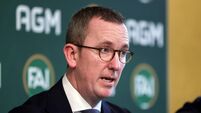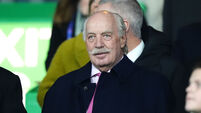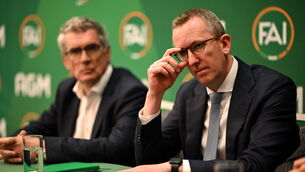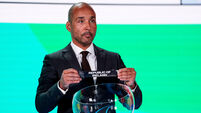Larry Ryan: Jurgen Klopp v Roy Keane was football punditry’s ‘OK, boomer’ moment
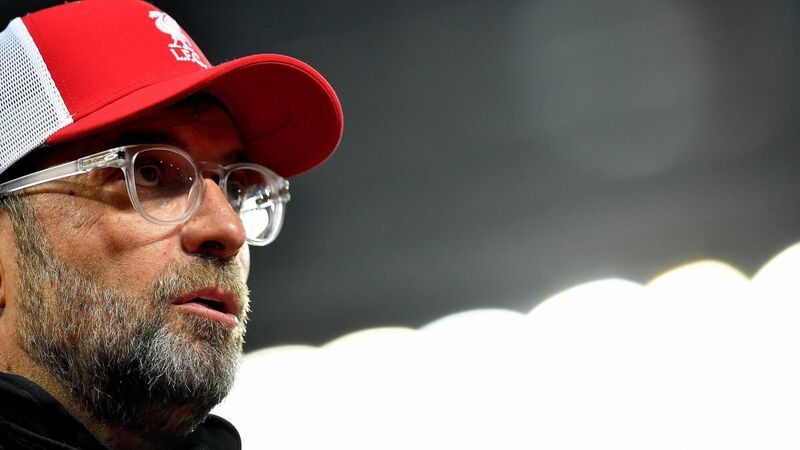
Liverpool manager Jurgen Klopp speaks during a television interview after last Monday's meeting of Liverpool and Arsenal at Anfield. Picture: PAUL ELLIS/POOL/AFP via Getty Images)
Perhaps some people missed the second leg of Liverpool’s tandem takedown of Roy Keane.
The day after Jurgen Klopp rebuked a retreating Roy live on Sky Sports for daring to call the Reds ‘sloppy’ against Arsenal, there was John Aldridge in his newspaper column, ‘defending’ Keane the pundit and describing him as “a great sidekick for Jamie Carragher”.
Ooof. Reducer followed by horror lunge.
Yet rather than make this all about Liverpool versus Manchester United, which is essentially what everything in life ultimately boils down to, the Klopp-Keane ‘clash’ was also a ceremonial line in the sand bringing the curtain down on football punditry as we knew it.
We had just watched a game where Arsenal lined up with four outfield players in their own penalty area at goalkicks and attempted to work intricate triangles in order to get one of their centre-halves free at the corner flag, in a process that might eventually find a full-back in the centre circle. An ambitious enterprise that rarely worked but which Mikel Arteta clearly regards as a safer option than just lashing the ball up the pitch.
And afterwards this was confirmation from Klopp that the old vocabulary of punditry is no longer fit for purpose to analyse this game we are now watching. Among the top sides, there is no more ‘keeping it tight’, there are no more hatches being battened down or stalls being set out.
It was football’s ‘OK, boomer’ moment.
To some, watching this type of match, where Liverpool defended their half rather than their box, and Arsenal built attacks from their box, must be like launching Snapchat for the first time or encountering your first haircut with a line shaved into the side.
And this was a direct challenge from Klopp to Keano and Carra and pundits of their vintage and beyond to give up their old certainties and abandon the lingo that has served the analysis game well over the years. Specifically to give up their generational distrust of ‘the high line’.
“Nothing was sloppy, absolutely nothing,” said Klopp.
“We played the constant high line so how can you defend Aubameyang with the high line? But without the high line you cannot defend Arsenal. If you are that high of course there is some risk. But that’s OK.”
Football is by and large a risk-averse business. The great regard for the ‘tried and trusted’ is the fuel that powers the managerial merry-go-round. There will always be room for a safe pair of hands. Big Ron once coined the phrase ‘risk ball’ for, yes, the sloppy pass.
If we accept risk as a fundamental part of football, what other pillars of the game will fall next?
We are already disorientated and confused. We have no clue what’s a handball anymore. Most of the noise we hear is fake. We have just watched Roy Keane take a step back.
Now what else must we reassess? Should we envisage a recessionary future where 60% or 70% is deemed sufficient, rather than 110%?
Might we one day encounter a midfield maestro who is calm but just not collected?
Should conclusions be drawn in early morning rather than at the end of the day?
And for all we know, might it yet emerge that games are won on paper after all, rather than grass?
It is by no means Klopp’s first foray into ripping up the foundations of punditry.
The very construction of this Liverpool side confounded the central beliefs of the talking shop — that a title-winning team is built from the back.
Instead, Klopp first made sure everything was in full working order at the front before making some concessions to the prevailing wisdom about minimising risk and eventually signed a top top keeper and centre-half.
By Thursday night’s reunion with Arsenal in the Carabao Cup, Klopp’s hymn sheet was guiding Carra’s songs of praise.
“That is modern football. Top teams take risks, play high lines.
“Now and again they come a cropper and people say they play too high or shouldn’t play out from the back.
“But it’s part of the reason why they are successful.”
Meanwhile, having snookered himself on Monday with his otherwise effusive praise of Liverpool’s performance, his sidekick was almost certainly at home, mastering TikTok, getting parallel lines sliced into his barnet, and studying pressing triggers and passing channels — all the while dreaming of the moment he stands over a prone Klopp in an Old Trafford technical area.
But the key question remains why the Liverpool boss chose to take on this battle with the old punditry order.
Relieved of the need to bring a stadium along with him via his touchline theatrics, does Klopp just have some spare capacity at the moment? And this was just a little something for the faithful watching at home?
Was it, like everything else, all about Liverpool v Manchester United?
Or was it a leaf from Alex Ferguson’s book, who warned about tricky post-match questions from journalists and cautioned against “justifying your whole world to them”.
“There’s an art to not exposing the weaknesses of your team, which is always your first priority.”
Or is it a case that a restless Klopp already senses there are not many worlds left to conquer on the pitch? And has moved onto redrawing the entire landscape?
After just three matches, it already looks certain that Liverpool will retain the Premier League title. Indeed, if you were operating under old assumptions, your only worry might be how certain it looks. You could be concerned that they’ve almost scored too early, as the punditocracy would have it.
But we know better now than to believe any of that stuff any more.


